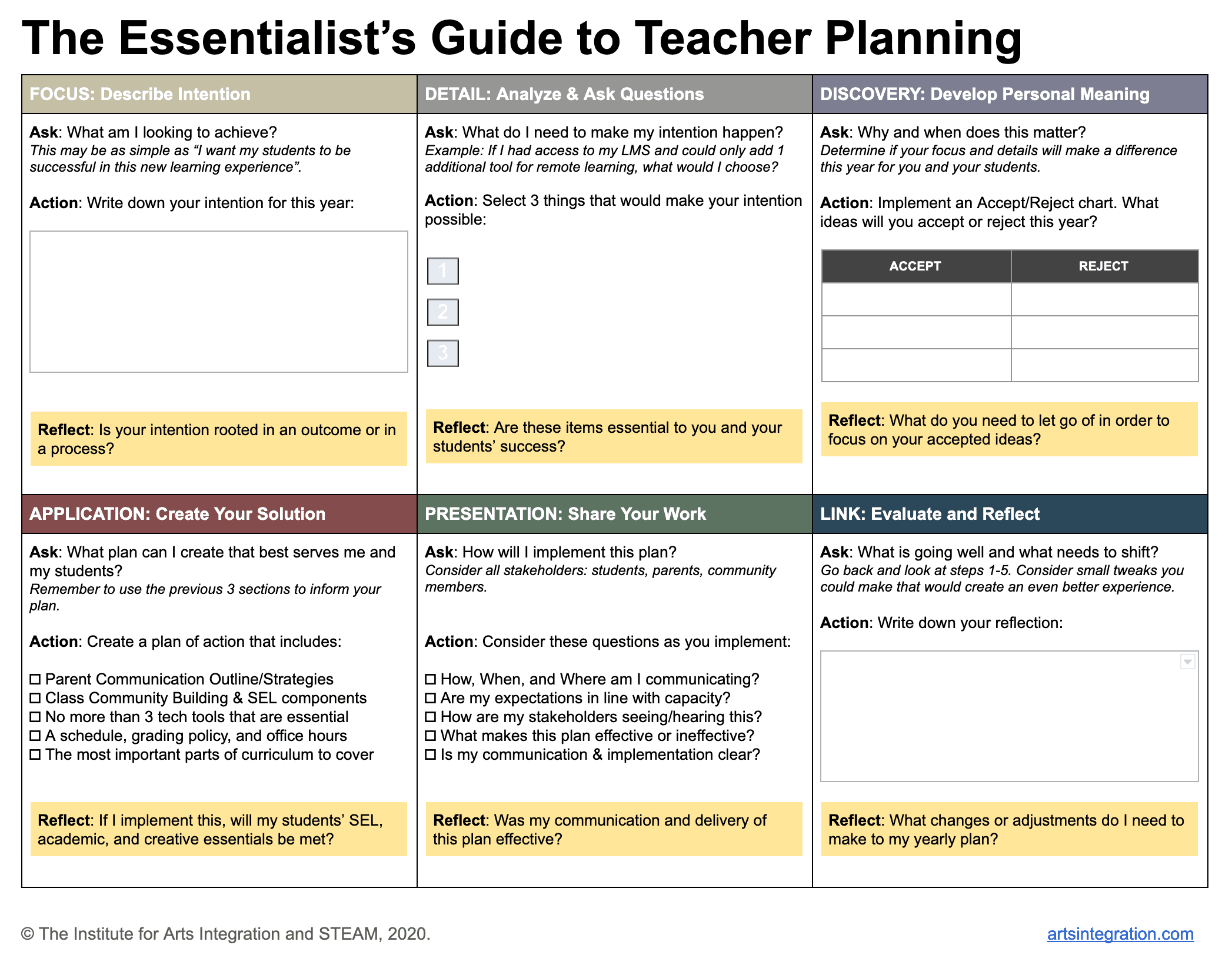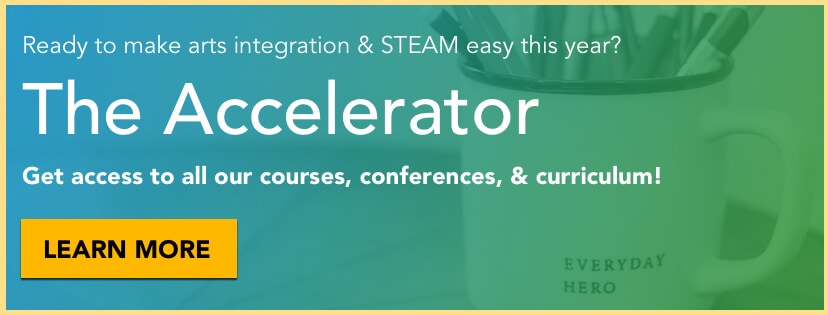The Essentialist’s Guide to Teacher Planning
9 Min Read • Planning
The old adage “How do you eat an elephant? One bite at a time” comes into play when it comes to teacher planning. And when you consider cross-curricular planning, it’s even more daunting. We CAN do this. But we need to be smart about it. As I was scrolling Twitter the other evening, I saw a great question:
If you HAD to teach remotely for a whole year and could only bring ONE tech tool (other than your LMS), which would you bring?
I love this question for a lot of reasons. But the biggest one is that it helps us consider what’s most important right now. Stop looking at all the lists and the tools and think: what’s one thing that you could use that would cover most of the bases. What’s essential?
The Essentialist Mindset
In Greg McKeown’s book Essentialism: The Disciplined Pursuit of Less, he shares the idea that Essentialism isn’t about giving things up. It’s about making intentional choices about what you want to include in your life. We’ve seen this idea latch on with Marie Kondo’s series and the question, “will this bring me joy?”.
This is a mindset we need right now as we head into teacher planning in the middle of a pandemic. Instead of continuing to collect ideas, it’s time to start considering what is absolutely essential to our students’ success and our well-being this year. That means that:
- we won’t get through the entire curriculum
- we will need to spend more time on relationship building and SEL activities to ensure our students (and ourselves) are okay
- we must be ruthless with our time
So how do we start? Even that question felt overwhelming. And then I remembered the STEAM process, which is a framework grounded in the design process that engineers use to help solve problems. What if we used that?
Using the STEAM Process to Design a Teacher Planning Framework
If we take the 6 steps of the STEAM process and use them to consider the essentials for connecting, teaching, and supporting students this year, this is what we get:
We’ve created this in a Google Doc and you can download a copy for yourself.
Let’s take a deeper dive into each of these 6 sections. I’ll share some additional resources in each to help you use this document in a way that is meaningful for you. I do recommend you use the print button and save this either as a PDF or bookmark it for future reference.

GET THE FREE SPREADSHEET
Scope and Sequence Planner
Collaboratively plan a year’s worth of Arts Integration & STEAM lessons in one document.
Watch the Workshop
Want to see a step-by-step on how to use this framework? Watch the mini-workshop below.
Ask, Action, Reflect
Note that each section has the same 3 parts: Ask, Action, and Reflect. As you begin each component, always start by asking yourself the question offered. Often, our work is informed best when we ask the right questions. There are examples under each “Ask” which act as a prompt for consideration. But you can expand or review these questions in any context which is most helpful for your situation.
The Action section offers a specific activity or action to take based on how you answered the Ask. Think of this as the bites you take of that elephant. Each action is specific and shouldn’t take a lot of time. But it’s important because it causes you to build momentum. The hardest thing for most of us to do is get started. But it becomes much easier to keep going once you have some momentum. So be sure not to skip this part!
The Reflect section helps you ensure that the Action you took is connected to your Ask. Use this as the “double-check your work” section. By considering the reflection (and making any adjustments needed), you’ll ensure that your plan is strong and will work for your needs.
Section 1: Focus
When we set out to plan for the year – whether that is for in-person, remote, or hybrid situations – we need to do so with a specific focus in mind. What’s the goal? The goal can’t be to get through the entire curriculum like always when we’re in a pandemic. So you’ll need to adjust your focus. That means setting your intention for what you most want to achieve this year with your students, parents, community, and yourself as an educator. Some things to consider:
- What is the most basic achievement you want for your students?
- What kind of relationships do you want to build in this environment?
- How do you want to experience this year?
Yes – you get to decide how you will move through this season. But it’s easy to forget that when you’re knee-deep in teaching 25 learners. So it’s important to write these intentions down. These will guide the rest of your planning process, so be specific but not lengthy. You want to write it in a way that’s easy to remember and remind yourself of when the going gets tough.
Notice how these questions and their answers shift how you might adjust your teacher planning focus. For example, the question is “what is the most BASIC achievement you want for your students?” not how you’ll get all of your students to achieve at or above grade level across the board this year. This now gives you the ability to reconsider the components of your lessons and expectations for the year. And it will give you the powerful ability to let go of what is not going to serve your students most.
Also, look at that reflection question. Sometimes we need to consider the outcome, and other times, we need to focus on the process. Which one is most important for you this year?
Section 2: Detail
Once you know exactly what your overarching goals are for the year, you can begin to consider what you need in order to make those goals a reality. This may mean considering what tools, processes, and strategies you already have/use that would help meet your intended focus. It could also mean researching and trying new tools, processes, and strategies.
The key in this section is to keep it simple. Select just 3 things that would help make your focus area possible. That might look like trying one new tech tool this year, using the See, Think, Wonder strategy each day as a warm-up to build critical thinking skills, and including a 30-minute office hour once a week so students can meet with you to ask questions and build relationships.
By narrowing your action list to 3 things that have a direct impact on your intention, you’ll be able to save time, energy, and have peace of mind knowing what you’re doing will actually move you forward.
Section 3: Develop Personal Meaning
This may be the most difficult part of this whole process. This section offers an opportunity to look critically at what we perceive as expectations and decide which we will accept and which we’ll reject. For example:
- Will you accept or reject the idea of working 10+ hours a day to get everything done?
- Will you accept or reject the idea that there is no time for creativity, inquiry, and collaboration?
- Will you accept or reject the idea that remote learning cannot be effective?
There’s no right or wrong answer here. Instead, make a list of what you perceive to be expectations of you in this current situation. And then consider whether these ideas/expectations are something that you will accept or reject. Then, place them into the appropriate column of the teacher planning tool.
This exercise helps you determine your “why” for the tough choices you’re going to have to make this year. As you look over your list, think about what you’ll need to let go of this year in order to focus on your accepted ideas. This can give you a lot of freedom, but can also feel scary. Remember: you can’t do it all and do it well.
Section 4: Application
This is the section where most people mistakenly begin. You can’t create before you understand the problem, decide where you’ll focus your efforts, and analyze the current solutions. Now that we’re here, it’s time to actually craft a teaching plan for yourself that meets your intention, embeds your essential action items, and which aligns with what you’re willing to accept this year.
This plan doesn’t need to be an essay. In fact, the shorter it is, the better. You’re really looking to create an outline which addresses these main sections:
- Parent Communication – check out this great parent communication tool for remote learning
- Class Community Building & SEL – try these ideas for connecting in-person or online
- Essential Tools for Instruction – this is a basic list that will get the job done
- Organization (including schedule, grading policy, and office hours) – watch this 30-minute setup tutorial with workbook
- The components of the curriculum which are critical for students to know
Section 5: Presentation
Now that you’ve created a plan that helps you zero in on what’s important, it’s time to implement it. Start using what you created and see how it works. Here’s the big takeaway to remember: don’t hold any expectations for this part. The plan may work beautifully and you may feel excited to finally feel like you’re able to handle this new learning environment. The plan may also totally flop and you might need to try again. If the plan doesn’t work in whole, that doesn’t mean it’s a waste. It could just be you need to tweak a few things.
Use this phase as a way to test and observe what works for you and what doesn’t. And don’t forget – what works for another teacher may not work for you. Don’t be discouraged if it feels like everyone else is getting the hang of this and you’re not. You just haven’t found the right groove for you. Look at your plan critically and try adjusting one of the 3 action steps in Section 2 or perhaps one of the steps in Section 4. Make small iterations until you find your successful sequence.
One thing to consider in this section: your power questions. These are the items you want to be checking in on a regular basis:
- How, When, and Where am I communicating?
- Are my expectations in line with capacity?
- How are my stakeholders seeing/hearing this?
- What makes this plan effective or ineffective?
- Is my communication and implementation clear?
Look at these questions as objectively as possible and use your answers to re-inform your plan.
Section 6: Link
In this final section, we’re reviewing your plan as a whole over the course of the year. Use this as a critical reflection of what shifts you can make to develop something even better for the future. This is where the real magic happens. When we ran our first Arts Integration Certification cohort, it looked very different from what happens today. Each year, we review what works, what doesn’t, and make small changes that transform the program and makes it better. You can do this, too.
Sometimes we forget that our plans, implementation, and outcomes don’t have to be perfect. More than that, they shouldn’t be. We work with humans – not machines. So everything is constantly evolving. This section helps us recognize that and use it to improve.
Try using this teacher planning framework this year to help reduce overwhelm and burnout. Most of all, remember that teaching is about more than curriculum and standards and assessments. It’s about connection and the joy of learning. And that can happen anywhere.




